Chris Baty's Blog, page 38
May 24, 2021
Organizational Writing Methods for Messy Minds

Long-time Wrimo and soon-to-be published author Anna-Maria Ninnas is a Project Manager with a talent for organizing chaos into coherence. She has been test-driving software to find novel solutions for myriad rampant writerly woes and has put together this comprehensive overview to share some of her best technology-based tips with the community!
Sometimes, you need to put your creativity inside a box.
This couldn’t be more true for writers with a messy mind. The limitless possibilities of a blank page makes me freeze up. However, tell me to create a story out of the magnets on my fridge or using only Cards Against Humanity, and suddenly the limitations of these microcosms give me both a starting point and some rules to activate the brain’s problem-solving function. It takes a shelf to organize your stuff, and the same goes to your writing.
Which is why I love using digital tools and story progression ‘rules’ to find the right crooked mile to weaponize my hyper brain. Today, I’d like to share some of my tricks and digital workspaces with you.
For me, taming my buzzing brain always starts with Trello. I can just move the cards around, like I’m solving a puzzle, which is extremely satisfying and fun. By gamifying the untangling process, I find myself super focused with a visual aid for problem solving. It’s amazing for non-linear thinkers.
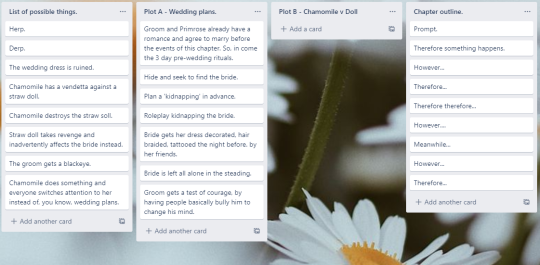
Here we have Chapter 6 of my current manuscript, Chamomile. I began the first draft by dumping everything that happens or could happen in this chapter. Just go crazy! If you have more than one subplot going on, you’ll love this. For me, Plot A is my young character Chamomile being at war with a vengeful straw doll. Plot B, the village is celebrating a wedding. Later I will ‘braid’ these two plots together, to have the paranormal events of Plot A ruin Plot B by all means possible.
When figuring out the flow, one of my favorite techniques is Therefore/However. It helps to figure the logic and flow of events step-by-step, ensure that consequence always follows, and dictate tension! Sometimes I’ll break the rule with more than one ‘therefore’ consequence, or a ‘meanwhile’ when intertwining a secondary subplot. Keep it as simple as cause-and-effect if you’re still trying to figure out how something could happen and why. Eventually, you’ll have an outline that might or might not look like mine:
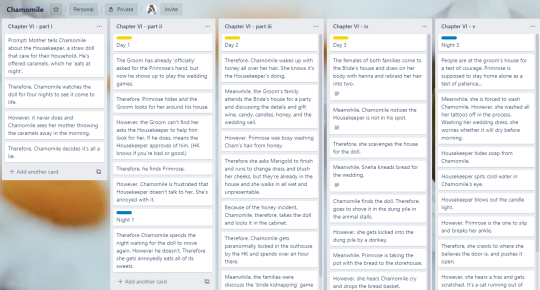
You can utilize colored labels for characters, section breaks, or even a green-yellow-red system for every card to track your passive, urgent and action voice.
But let’s say you’re editing or on a #JustFinishIt marathon. Well, your Google account already has all the tools to tame your focus in a single window.
Opening your blessed auto-saving Google Doc, by default you should find the holy trinity of organizing — Calendar, Keep, and Tasks.

I love Keep for its simplicity. If I’m on the go and come up with the perfect line, find inspiration or remember a loophole to edit later, I whip out my phone, save, move on. I use labels only to separate my novels, occasional hashtags.
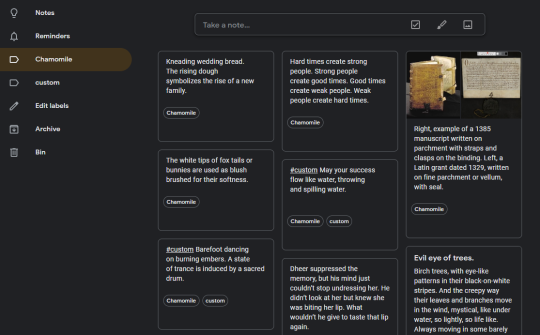
The beauty of it is that you can use Keep while you’re in Docs. Since you’re guaranteed to get distracted, why not use it to your advantage by choosing what you’re distracted by — like scrolling your own notes in the sidebar instead of Pinterest! Scrolling social media is addicting because with so little movement we get infinite information, barely losing any calories — your brain loves the efficiency. Get addicted to your novel instead!
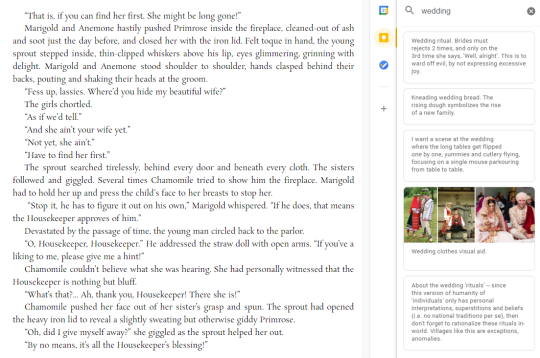
The search tool is not the only benefit. You can cut-and-paste entire sections that ‘don’t work’, but you like and might adapt elsewhere. Slap them there for safekeeping. You can write down a plot bunny, a topic to research, an important reference to keep in mind for Chapter 23, a new idea or editorial notes. Multitasking is a breeze. Pin the notes you find most relevant right now to the top. Notes you create while in the Doc automatically tags it as ‘related’, so later in Keep you can filter notes related only to that one chapter — which is why I separate my chapters doc-by-doc!
Google Tasks are amazing for editing. You can make the checklist as you re-read after a break, a list for each chapter, so you can later go back and — oh yes — tick the boxes off one by one, knowing exactly what you’re doing, to fix loopholes and add missing elements.
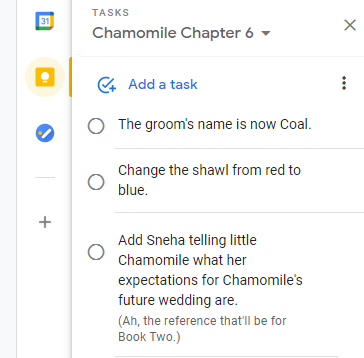
Last but not least is the simple genius of Calendar. If you have multiple plotlines, characters, or maybe even time-travel involved, then the overlapping schedules of Google Calendar—which, yes, you can drag and reorder—is gorgeous. Now, because all these methods are pick-and-choose on a need-to-untangle basis, I wasn’t using it in this chapter much. However, it did come to help when I was trying to figure out the time window just before Chamomile gets into trouble—again—when it was time to leave the bride home alone as a test of patience, to justify how she ended up babysitting instead. (Because you had to go into the storeroom in your wedding dress, Primrose, and now you have to wash the dress. What a convoluted way to break your ankle tonight before your wedding.)

And this is just a recent, as-I-do-it example of some ways I handle my comprehension of my own story! Would you have adapted these tools differently? While it may look over-complicated to some, for me it’s the only way I can tame my head when ‘sit down and write’ sounds impossible, and I know I’m not alone.
There are many free and subscription apps you can use to organize your writing. Try them, make use of tech! Find your carton ‘box’ that’ll unleash your creativity and help you build forts. Once you discover how that beautiful mind of yours expresses itself and find an analogous method to translate it, trust me, your craft will bloom.

Anna-Maria Ninnas studies anthropology and contemplates humanity through the lens of fiction. A project manager by vocation but extremely unorganized by nature, Anna-Maria tries to hack the art of writing with all sorts of cheats, methods and problem-solving techniques. You can read Anna-Maria’s tips for all the other chaotic creative minds on Medium. The novel Chamomile is coming out April 2022 no matter how messy or unfinished it is!
Top photo by Ross Sneddon on Unsplash
May 17, 2021
Overcoming the Writing “Taste Gap”

Jamie Fuchs has been a dedicated participant in NaNoWriMo for roughly a decade as she strives to bring her ideas to the page. She’s here to discuss how to overcome the doubts and imposter-syndrome mentality that become a barrier when we feel like we don’t fit a particular mold of success:
I’ve spent years comparing my writing to the final polished works of authors with decades of experience under their belt, and the idea that I’ll ever be able to match such feats overwhelms me. I’ve found myself so mentally immobilized by it, I seldom allow myself to begin. If you don’t start, you can’t fail, right?
Ira Glass coined the term “Taste Gap” to explain where this fear comes from — suggesting that it’s in our nature as creative types to have good taste, but our current skill level may not be up to par with that taste.
Somehow, I’ve convinced myself I’m a writer. I’ve maintained detailed files of my ideas. I’ve read widely on many subjects by a variety of authors, to educate myself and for pleasure. I’ve joined all the Facebook writing groups and shared all the inspirational memes on social media.
My dilemma, however, is clear: I’ve stunted my writerly growth because I’ve failed to actually write.
Not all the time. Sometimes I manage to squeak out an interesting blog post or essay. I’ve even successfully committed to a daily morning pages habit, which has helped me work through some personal challenges.
Overall, though, the consistency hasn’t been there. Too often, I come up with excuses for why I can’t write today. The house isn’t clean. I haven’t spent enough time with my friends or family this week. I’m too tired or too old (maybe both?). And then I beat myself up over it when I succumb to these justifications.
I’m constantly seeking writing advice, and some version of “daily writing habit,” appears in nearly all of it. I’ve wondered to myself what it must mean if I’m failing to achieve this relatively simple suggestion. Do I just not have it in me?
The part of me that clings to my future author status refuses to believe that. I’m more inclined to believe I need to figure out how to move forward. How do I, as an insecure perfectionist, give myself permission to write? What can I do to feel as though my writing is valuable to the world?
Because let’s get real. We all face unique challenges in any creative pursuit. It would be lovely if we could all quit our jobs tomorrow and write for a living, but the fact is we have different priorities and demands on our time and a variety of internal and external hurdles to overcome, including the need to pay our bills.
That’s why writing advice can be dangerous to our psyche if we take it as gospel. While it’s helpful to learn from the masters and evaluate the habits and rituals that work for them, we need to develop our own methods in the end, as no two paths are alike.
I’ve been working on my own methods lately, and it has led to a couple of major insights. First, I’m learning to accept the dreaded Taste Gap. I have these amazing stories in my head, but I haven’t quite figured out how to rip them out of there with any sense of coherency. The idea of the Taste Gap gives me hope, though, because I know I’m not alone. We all start at different levels, and only practice and commitment to our craft will make us better. First, we must allow ourselves to suck.
Second, I’m learning to accept I’m on my own path. Sure, I’d love to publish my work one day, but for now I know writing brings me joy. Through writing, I can connect with people in ways I haven’t been able to via other forms of communication. This is my Why.
And this is where giving myself permission really shines. I’m going to start small and ignore the naysayers because I only need to measure up to my own standards. I may never be as prolific a writer as Stephen King and Brandon Sanderson, or as excellent a storyteller as Neil Gaiman, but I no longer think it matters. If I stay in my own lane, I won’t have time to worry about anyone else surpassing me.
Besides, different doesn’t equal less worthy. It’s what makes this world a delight.

Jamie Fuchs hails from Cincinnati, OH, where she works as an accountant by day and a bartender by night. When she’s not slinging beers and crunching numbers, you’ll find her cooking new recipes, hiking the local trails, nerding out over all the books, or agonizing about her writing. You can visit her at The Wocka Spot or on Medium, Instagram, Facebook, and Twitter @JamieFangtastic.
May 10, 2021
Reclaiming My Life by Writing a Novel

Sarah Hughes is a NaNoWriMo Winner and someone who’s turned a series of hard knocks into fuel for her writer’s forge. Sarah shares an inspirational turning point in her life and how NaNoWriMo helped to facilitate a spiritual renewal at a time of great personal upheaval.
Last summer, I did the hardest thing I have ever had to do. Cutting toxicity out of your life sounds like it should be easy and simple, but that’s rarely the case. It can be difficult and scary—especially when the toxicity is coming from someone who is supposed to love and support you no matter what. In July 2020, I cut contact with my mother. That is when a new chapter of my life began.
Writing a novel had always been on my radar, but I always felt like it was too lofty of a goal for me. It sounded like something other people do. I grew up being constantly worn down about my dreams and goals to the point where I stopped making them. Each year as November approached, NaNoWriMo would light a spark in the back of my mind. I always put it out. I didn’t think my ideas were good enough and I definitely didn’t think I was capable of writing 50,000 words in just 30 days.
2020 was different. I found myself in the fall of 2020 starting my life anew. I was finally free from the control and manipulation I had lived under my whole life, and at 25 years old I was just starting to figure out who I was as a person. This was both frightening and exhilarating. November rolled around at the perfect time. Finally, I was ready to write my novel.
I jumped into November cautiously optimistic for what the month might teach me. I worried I wouldn’t be “good enough” or that I would burn out and quit halfway through. But those things didn’t happen. I found an incredible community of writers who welcomed me with open arms and made me feel like I belonged—a feeling that was new to me. I was eager to write every day, be it early in the morning or late at night. Some days the words flowed as easily as breathing; other days each word was a struggle. I told myself it would be okay if I didn’t finish. Just attempting was something to be proud of. Much to my surprise, November 30th came and I wrote my 50,000th word. My story morphed from its original plot of contemporary fiction/romance into a sci-fi saga about time travelers that I had so much fun writing.
“I felt empowered and like I could truly do anything.”My novel was nowhere near ready for anyone else to read, but that didn’t matter to me. All that mattered was that I had my mind set on doing something and I actually did it. Taking the scary step of cutting my mother out of my life showed me that I am in control of my own life. Participating in—and winning—NaNoWriMo was an exercise in proving it. I felt empowered and like I could truly do anything. Writing my novel helped me heal from my trauma, as is writing this very article. I will continue using my love of writing as a tool to connect with others who have experienced trauma. I will forever be grateful to NaNoWriMo for helping me on my journey towards reclaiming my life.

Sarah Hughes is a Louisiana-born writer and member of the LGBT+ community with a lifelong love of poetry and fiction. When she isn’t writing, she can be found canoeing and kayaking, reading tarot cards, or trying out new cooking recipes. She currently lives on the coast of Alabama with her husband and three cats. You can find her on Twitter and Instagram @sarahjadewrites
Top image licensed under Creative Commons from James Jordan on Flickr.
May 3, 2021
“Honor what you’ve accomplished, whether it’s ten words or ten...
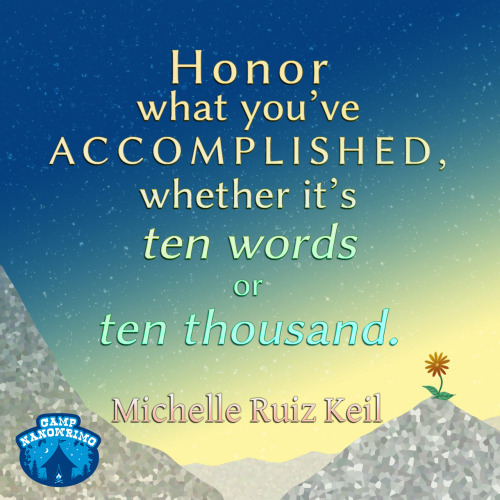
“Honor what you’ve accomplished, whether it’s ten words or ten thousand.”
—Michelle Ruiz Keil is a writer and tarot reader with an eye for the enchanted and a way with animals. Her critically acclaimed debut novel, All of Us With Wings, called “…a transcendent journey” by the New York Times and “…a fantastical ode the Golden City’s post-punk era” by Entertainment Weekly, was released from Soho Teen in 2019.
Did you reach your Camp NaNoWriMo goal? Let Michelle know, or thank her for her Camp Care Package!
Your Camp Care Package is brought to you by Camp NaNoWriMo. Join us for our next Camp session in July at nanowrimo.org!
Image graphic created by NaNoWriMo Editorial Intern Jordan Leigh.
Image description: An illustration showing two large grey, textured mountains in front of a starry blue and yellow background. An orange and green flower is at the peak of the smaller mountain, and the blue and white Camp NaNoWriMo logo is in the bottom left corner. Above them is the text: “Honor what you’ve accomplished, whether it’s ten words or ten thousand.” —Michelle Ruiz Keil”
April 30, 2021
The Nine Year Pursuit of 50,000 Words and a NaNoWriMo Win

Stacey Harris credits NaNoWriMo for kickstarting her success with novel writing, but she didn’t come by that easily. She’s here to talk about the long and winding road it took to reach that summit, some tips for breaking unproductive patterns, and how it’s never too late to arrive.
My first NaNoWriMo was November 2011—I wrote 5,263 words.
It took me 9 years—and 6 NaNo’s—before I would write 50,007 words and achieve my first win in 2019.
So, if you’re struggling to get your first win, well, this one’s for you!
It took 3 big changes in how I approached writing before I finally captured that elusive win. I’ve now won NaNo twice (2019, 2020), wrote a third 70k novel in three months in 2020, and I’m already excited for NaNo 2021.
PSA: What worked for me won’t necessarily work for you—but trying something new might help you achieve your NaNoWriMo dreams.
1. Find or Create a Writing GroupThe first big change I made was finding a local Toronto writing group that shared similar goals to mine. During NaNoWriMo we tracked our writing progress, set up additional writing sessions (virtually and in-person), attended local NaNo events, and boosted each other up in group chats.
Before 2019 if I had a hard writing day during NaNo I’d end up quitting because making up the missed daily word count was too hard to overcome. But my writing group held me accountable for my words and helped me keep pace and push through those hard days. Writing can be a lonely pursuit, but finding people with similar goals who were invested in my success—and I in theirs—made a huge difference in getting through NaNoWriMo.
2. Build a NaNoWriMo PlanBefore I lose the pantser’s, this one’s for you too!
We all know that writer’s block is the death of a NaNoWriMo win—which is why in 2019 I created a long list of scenes or ideas that I wanted to write. This way, when I was having a rough writing day, I had over 50 writing prompts ready to help get me going.
If you’re a plotter and already know what direction you’re going, but still manage to get stuck, I encourage you to skip ahead—no rule says you have to write in order! I’ve often found that the jump to another scene will unstick whatever block I’m having.
Remember, the goal of NaNoWriMo is to get 1,666 words down each day—do whatever you can to hit that number!
3. Reward Your EffortWriting 50,000 words in one month is incredibly difficult and you deserve a reward for your hard work!
Yes, the ultimate prize of NaNoWriMo is having 50,000 words and a nearly complete first draft. But when you don’t have a book deal, or even an agent, it can be tough to find the motivation to push through hours of writing every day on top of work, family, and social obligations.
That’s why in 2019 I promised myself I’d buy Scrivener if I finished. Set your own tangible prize that you only get if you finish NaNoWriMo (one of my friends bought herself a new laptop!). Sure, you can buy whatever anyway, but trust me when I say it’s much sweeter to know that you’ve earned it.
4. I Did it, and So Can You.Winning NaNoWriMo isn’t easy, but it’s so worth it to look back and see what you’ve accomplished. It took me 9 years of perseverance to get my first win and the pride I feel is unmatched.
If you’re reading this I need you to know that the writing journey only ends when you stop trying. So please, keep writing—I can’t wait to read your books someday. <3

Stacey is a reader, writer, and adventurer currently residing in Toronto. She lives for the days filled with friends, books, tennis, and falling on her butt as she attempts to learn snowboarding. You can find Stacey on Twitter and Instagram as @StaceyWrote where she talks about writing and whatever inane thoughts cross her mind — it’s a positive space that welcomes anyone and everyone so feel free to drop by and say hi.
Photo by Tania Malréchauffé on Unsplash
April 28, 2021
5 Tips for Finishing Your Novel

April’s session of Camp NaNoWriMo is drawing to a close, and you might find yourself nearing the end of your novel. If you need some tips on writing and polishing the ending of your story, author Derek Murphy is here to share a few! Plus, you can check out the rest of our novel-finishing resources on our #NaNoFinMo page.
You won NaNoWriMo and have a 50k collection of scenes and sentences, but how do you clean it up and get it done? How do you make sure it’s finished, satisfying and enjoyable? Here are 5 powerful strategies for finishing your novel and some helpful writing tips that will push you past the finish line.
1. Give it a satisfying resolution.In order to have a powerful story, your book should probably focus on a main character’s change or transformation. There’s an inner war, a.k.a. the character’s emotional healing, and an outer war: the conflict that forced the reckoning. If it’s a purely symbolic internal realization, you can mirror that with actual conflict in the real scene: the breaking of a dish, a fit of rage, a sudden ray of sunlight (or a storm… this should not be pleasant; It’s a breaking point and spiritual death/rebirth).
You can clarify the moment of change by setting up an illustrative contrast, a before and after, that shows how those internal changes have resulted in real-world consequences or benefits. Each character’s unique challenge will match their personal weakness or fear. The price for victory is the one thing they have so far refused to do, or something they cannot give up or bear to lose.
Make sure your protagonist has gone through a transformative struggle to arrive at deep insights, knowledge or awareness. Find a way to deepen the incidental scenes so that they become instrumental to a deeper purpose, leading towards an identity-shifting event.
The plot is what happens, and it’s important. But you can make it more dramatic and meaningful by making sure you demonstrate how hard it was and what it cost. It matters, it is remarkable, because it forced your protagonist to change.
Your conclusion might include:
Physical tension as allies perform a tug-of-war battle against resistance, that shows how difficult this struggle is, and how much force is required.The consideration phase, as characters are tempted last minute or the price for victory is revealed: the sweet memories that give them awareness that this fight is worth the cost or risk (you need to show them making the choice, knowing what they will lose).The final flashback, as the full backstory is revealed so we can see exactly why this conflict is so difficult or meaningful for the main character.2. Add (unresolved) conflict.Your story is made up of the events and scenes, where something happens. Each new event will push the characters further into the plot. Slow scenes where nothing is really happening can be red flags, so the first thing to focus on is increasing conflict, drama, suspense and intrigue. This is what creates urgency. The full reveal, demonstrating why THIS challenge is so difficult and powerful, should happen just before the final battle or resolution.
You want to make sure every scene, especially in your conclusion, has enough conflict. I recommend these three:
Outer Conflict (threats): Challenges or obstacles that prevent the character from achieving goals.Inner Conflict (doubts): Moral struggles, decisions, guilt or shame, anger.Friendly Fire (betrayal): Strong disagreements between allies or supporting characters.You want to extend and deepen the potential conflict, without resolving it too easily. The biggest destroyer of conflict is conversation: when your characters just sit around and talk to each other. Most conflict involves a lack of information, and a desire for clarity. A lot of conflict is perceived or imagined.
The most important information needs to come last, and come at a great price. The information that has an emotional impact, and influences their actions and decisions, should be big reveals at dramatic peaks. A surprise or twist should be treated as an event: each scene is leading towards a change or new piece of information that provokes the protagonist to respond.
3. Fill plot holes with character motivation.After you’ve made sure that “what actually happens” is intriguing (opening questions and raising tensions without resolving them) you can focus on making sure the plot holes are filled, and characters are properly motivated – these two things are usually adjacent.
You can find and fill plot holes by asking:
Why are the characters doing this?Why does any of it matter?Basically, readers need to respect the main characters enough to care what happens to them, so their choices and actions need to make sense within the given information. If there’s a simpler, easier solution, readers will get stuck up on “why didn’t they just…”? To fix plot holes and gaps in logic or continuity, or make the story go where you need it to, you can add urgency, fix the mood of the scene (bigger stakes require bigger justifications), show characters in a weakened mental state, or raise concerns but have them dismissed, with an excuse or justification.
You need rational characters to make plausible choices that lead to dire consequences. You need show why they don’t do something easier, or nothing at all, or why they face clear challenges, despite potential obstacles.
They’ll also require a deeper motivation, for why they’re willing to put themselves in identity-destroying conflict, rather than just giving up or running away. Why do they stay in THIS fight, when they’ve run from similar ones? If they weren’t ready at the beginning, why are the ready now – what changed in them, as a result of your story’s journey?
Your protagonist needs to have a strong, consistent internal compass, and it needs to be revealed through incidents that establish their character. This is who they are. Without this reliable core identity, we won’t be able to tell a story that forces them to change.
4. Let readers picture your story with detailed description.In the final stages of revision, you can begin improving the description with specific details.
It’s smart to start – or end – a chapter with a vivid, immediate scene. You want to leave readers with an image they can see in their minds, hopefully connected to the feeling you aim to evoke. You can close a chapter with a reference back to a motif or image, with a deeper or more reflective context; applying meaning to the metaphor. This will help readers feel engaged, be moved, and leave a lasting impact.
Vivid scenes are mostly a matter of detailed description, so add the specifics about the story environment. Be precise, not vague. Instead of “she put a plate of tea and snacks on the table” you can write “she gently placed an antique porcelain teapot on the table. I could smell it was Earl Grey from the scent of bergamot. The half-sleeve of Oreos and can of onion-flavored Pringles seemed incongruous with the fancy dishes, but I knew she was making an effort to welcome me.”
Focus on the sensations and feelings; but also zero-in on any potential sources of conflict or internal emotions or states of mind. In my example above, the host might be nervous or ashamed of her spread; or perhaps she has a degenerative brain disease and doesn’t notice the incongruity. Tensions are unspoken, potential sources of negative feelings. They hover in the background of your description.
Readers will remember the pictures you put in their heads, not the words on the page.Description should serve and be bound to the story, not distract from it.It should be squeezed into and around the scene action, when the protagonist is using or exploring.Show what’s different, not what’s the same.Leave space for readers to fill in the gaps, but get them started in the right direction so they aren’t surprised later.Sidenote: be careful about your metaphors, analogies and similes. Each one will put a picture into readers’ minds, and it can quickly get overcrowded with imagery. You’re asking them to ignore your real scene and think of something else. Use them to confirm and amplify the scene you have, and limit distractions.
5. Prepare to publish.Typos are bad, but perfectionism will ruin you. This section is about editing and proofreading, but I don’t have time for all that, and you don’t either. The real problem with a story is rarely the number of typos. A very clean book isn’t better if people stop reading.
You can solve a lot of common writing problems, with my big list of 25 common writing mistakes, and self-edit your manuscript to make it as good as possible. After that, a copyeditor or proofreader isn’t always the best investment (and it can also be the biggest publishing cost).
Instead, use an editing software (I like Grammarly) to root out obvious mistakes, but don’t dwell on the small stuff like perfecting every word or rearranging the commas. Spending a very long time wrestling a poorly-written manuscript in shape is less effective than getting something (actually) done to the point where you’re comfortable sharing it.
This may be difficult at first, but you can’t learn and improve without genuine reader feedback (from people who aren’t your mom or best friend; nor the short-sighted opinions of a self-proclaimed literature enthusiast). You need to find readers who enjoy your particular genre, and the sooner you find them, the more valuable feedback you can get.
Shorten the feedback loop: Get over the fear and focus on learning by getting feedback early and often. However, this doesn’t just mean joining a writer’s club: writers are brutal and might focus on trivial things. The safest bet is to make it public, on Wattpad at least. Or get a cheap cover and throw it up on Kindle, Draft2Digital or even your own blog.
Making it public is scary and vulnerable, but it’s better than letting the fear of messing up keep you from the brutal, necessary experience of allowing readers to tell you what they liked and disliked about your writing. Will some people be critical? Yes! But guess what, you’ll get negative reviews even if you’re a brilliant, famous writer. Those are inevitable. And the first negative reviews may teach you more about writing than 10 years attempting to self-edit, afraid of putting your book out into the world.
PS. You can use resources, like my 24-chapter plot outline, as a way to spot story gaps in your manuscript and improve the structure (especially if your book suffers from a “soggy middle.)

Derek Murphy has a PhD in Literature, writes urban fantasy and is the founder of the alliance of young adult authors. More recently, he’s started sharing writing tips on http://www.writethemagic.com
Top photo by Adegbenro Emmanuel Dipo on Unsplash.
April 27, 2021
"So often, we think we want to write one thing, but our subconscious knows better. If something in..."
-
Michelle Ruiz Keil is a writer and tarot reader with an eye for the enchanted and a way with animals. Her critically acclaimed debut novel, All of Us With Wings, called “…a transcendent journey” by the New York Times and “…a fantastical ode the Golden City’s post-punk era” by Entertainment Weekly, was released from Soho Teen in 2019.
Your Camp Care Package is brought to you by Camp NaNoWriMo. Sign up to receive more Camp Care Packages at nanowrimo.org!
April 26, 2021
How to Use Brain Science to Win NaNoWriMo?

Maayan Sulami is a Tel Aviv-based writer and podcaster, and has been actively invested in NaNoWriMo since 2016. She comes armed with insight into the inner workings of the mind and how a deeper understanding of brain mechanics can give us the tools we need to fine-tune our process and get things running smoothly.
Brain science has explained so much of our behavior patterns over the past decades, and the findings are amazing. Our mind is a complicated machine, but when you know the mechanism, you can use it for your advantage.
NaNoWriMo, being such a huge challenge, makes us rethink our work process and push our boundaries — no better time to combine brain science with writing. Here are the main challenges you might face during NaNo and how you can battle them using mind hacks.
ProcrastinationProcrastination is a clash between the prefrontal cortex — the planner and rational decision maker (Basically the Friends character Monica Geller), and the limbic system that wants to feel good right here, right now (aka the instant-gratification seeker, aka the character of Rachel Green). And it’s one of the most dominant parts of the brain! That’s why it wins more often.
We procrastinate when the limbic system wins. Psychologists call this “present bias”; it means we tend to give more weight to payoffs that are closer to the present time. Which means that watching Netflix will most likely win over a writing sprint.
One way to battle this is to have small instant rewards when small tasks are done, and not wait to feel the fulfillment when you finish NaNo or even ‘til the end of the day. Have small rewards throughout the day (get a coffee, take a bath, have a snack) — that way the writing sprint has a chance to beat Netflix.
Another way to bridge Monica and Rachel is to re-create self-trust, meaning starting to close the gap between what I say I’m going to do and what I actually do. Procrastination basically means thinking A and doing B, this creates discomfort in the brain (which means discomfort in your body) and this is called cognitive dissonance. When you do what you actually say you’ll do, that also gives you instant gratification (bc there’s no more dissonance). So when battling with procrastination, try and do the smallest, easiest task on your list; that will make the limbic system happy, and will help with getting the rest of the stuff done.
The Emotional BrainWhen we’re sad, anxious, or even dehydrated or sleep-deprived, the brain is lacking resources. In order to get those resources back it’ll take them from other parts — usually the Monica Geller part; the one that makes good decisions. So make sure you self-care: eat well, drink a lot of water, get enough sleep and try to relax (you can use breathing techniques to increase levels of relaxation during the day — apps that are great for that are Headspace and Oak breathing app).
MotivationNavy Seals sing when they run (“I want to be a Navy Seal’’ — google it) and this isn’t just for morale. When they sing, their brain thinks that they’re enjoying it, and it connects that happiness to running. If you help the brain connect writing with pleasure, it’ll be easier for you to actually sit down and write. Like we said, the Rachel Green part is gonna want that immediate pleasure.
A crucial principle to be aware of is that the brain doesn’t do such a great job at differentiating reality from imagination. That’s why we get scared when we watch a horror movie, even though we know there’s no actual danger, or why we salivate imagining eating something delicious (it’s also why “fake it until you make it” is a real thing). This means the brain will believe what you tell it to believe. Repetition is one of the best way to do this, so if you like mantras/affirmations, make a special one for NaNo and your writing challenge and repeat it every morning.
Writer’s BlockCreative thinking is a very mysterious process in the brain. it has nothing to do with the left or right parts of the brain; that’s just a myth. When we create, parts all over the brain are activated. But since it’s a very vague concept, it’s harder to explore. However, studies show that imagination and creative thinking are linked with memory. Participants’ brains were scanned while they were remembering a past experience, then imagining a possible future experience and then thinking of creative uses for an object. All three actions (remembering, imagining, creating) activated the hippocampus — the part in our brain that creates and stores memories.
They also found that after asking participants to recall a detail in a recently watched video, they were able to come up with more ideas, and the ideas were more versatile. So next time you’re stuck with a creative problem, try to imagine a past experience with as much detail as possible. This might give you a short-term creativity boost to generate more ideas.
Fun Fact About Creativity and Inspiration:Issac Asimov wrote about 500 novels. In his biography he wrote that he chooses not to wait for inspiration, and if he struggles with a novel, he just does something else instead — writes an article, a manual, a short story, or works on a different novel. This fills him with more motivation to do things. Action begets motivation begets action, not the other way around.
One last word on change. In the past, scientists believed the brain stops changing and evolving when we’re children; now we know that we form new neurons and neuron connections all the time (neuron connection is basically how we think better and faster, how we make decisions, etc). Meaning, our brain can change for the better throughout our lives. It takes effort, but it’s the most important work we’ll do. 😊
References
The Willpower Instinct — Kelly Mcgonical
Core Network Contributions to Remembering the Past, Imagining the Future, and Thinking Creatively — Journal of Cognitive Neuroscience
The Creative Brain — The Dana Foundation

Maayan Sulami is a writer and podcaster presently working on two debut novels; a light romcom and a dark thriller (we’ll see which one is done first). Maayan feels the balance between those two genres basically defines who she is as a person. She loves storytelling and analyzing great stories — which is the subject of her podcast — and she believes she could’ve been this generation’s Lorelai Gilmore if she were just a little taller.
You can find more of Maayan at her blog, Maayanwrites.com, or on insta @maayan_writes. You can also watch her short film on Youtube and read her short story at Sffplanet.com.
Photo by Ashley Batz on Unsplash.
April 23, 2021
5 Tips for Fast Drafting from a New York Times Bestselling Author
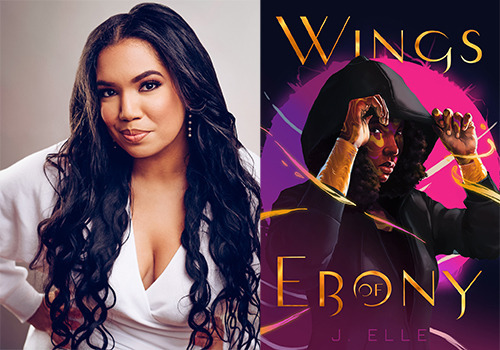
NaNoWriMo is basically an exercise in fast drafting: getting as much of the first draft of the story as you can on the page as quickly as possible. Today, bestselling author J. Elle is here to share some pro tips for fast drafting:
My first middle grade novel took me nine days to write.
The first draft was about 40,000 words or so. And yes, it needed to be revised before it sold to a publisher. But the meat of the story was on the page in just over a week’s time. I’d never drafted anything quite that fast before. Within a single month I’d written an entire novel, revised it a couple times and readied it for sale. A few months later that novel sold at auction and will be on shelves May 2022.
I still look back on this feat with a bit of shock and awe. To date I’ve sold five novels to major publishers, two young adult, two middle grade and one non fiction and my experience fast drafting has forever altered the way I approach writing. I should mention, fast drafting isn’t for everyone. Writing is such a personal thing and each storyteller has their own process, but in the event getting the first draft out is the biggest hurdle for you, like it is for me, I’m going to share five tips for knocking out that first draft in record time.
1. Start with a SHORT story pitch.Pitching a story in a few words is tough. But it’s a worthy effort and the best use of your time before you get any words on the page. Why? Because it helps you hone in on the core of your story and its hook. A good short pitch involves the character, their dilemma, and a hint of the stakes. In October of 2018 I pitched my YA debut novel in a tweet which then blew up. Not many words can fit in a tweet, but by choosing the right set of words, I was able to convey the heart of my story and it really resonated. (From that tweet, I signed with a literary agent and sold my debut novel to a Big 5 publisher in a six-figure-deal.) The biggest favor you can do for yourself is understand the story—its essence, its core—you’re trying to tell before you start drafting. And that’s hard. But the more you play around with creating a short pitch, you’ll begin to see a clear snapshot of what your book is going to be about. That’s your jumping off point.
2. Expand your pitch into tent pole beats.From your short pitch, spend some time deciding on what your major beats are. Now, yes this is a bit like outlining. And for you pantsers out there, I empathize with you. I was a pantser and still am in many ways. But I still do this step because this step ultimately saves me time. The beauty of fast drafting is that you know what you need to do when you sit down to type. So a lot of these steps are about doing pre-work so that when you sit down to type you’re not spinning your wheels to figure out what to type. Instead you’ll have a clear goal and you’ll be ready to execute it. Also, note that the goal isn’t to perfect each of these steps, but instead to try to do each step, to the best of your ability, and in a way that makes sense.
I could write an entire piece on beat sheeting novels (which I love and do for all my books), but for the purposes here, I’ve organized the main things you want to know below in a series of questions. Simply answer each, make a chart if you like that sort of thing, and once you have each question filled out in a way that logically makes sense, move on to the next step. (NOTE: It’s a good idea to get feedback on this step if you have critique partners and fellow writers you trust.)
Opening Scene - Who is the character before the world changes?Inciting Incident - What happens that forces them to make a choice, changing their lives forever? What are they choosing between? “A” Plot - What is that choice they make? What are they pursuing or working toward? Finding information? Going on a quest? Uncovering the truth behind a murder?Stakes - What are the stakes of the “A” plot? What’s at risk if they fail to accomplish whatever they’re pursuing? It should be something that personally affects them or someone / something they care about. “B” Plot / Character - Who or what is the theme of the story? What character in your story is going to embody that theme and play a key role in helping the main character change?Midpoint - what happens in the middle of the book to change the character’s direction. Usually it’s some bit of new information or they realize things are not as they seem. Stakes Raise - How do the stakes (what’s at risk if they fail) raise after the middle of the book? Character Arc - what does your character believe about the world in the beginning of the book that by the book’s end they will no longer believe? (An extension of this question is: what things can happen in this character’s life to facilitate them incrementally learning this big truth? If you don’t know this question right off, that’s okay. But this is a question you want to go back to every now and again, even after you finish the first draft, to ensure your character is actively involved in a plot that is resulting in their change.)Failure - How will your character fail big? This happens at about the 75% point of the book and it’s the final moment of failure, usually, before they pick themselves up off the ground (figuratively or literally) and learn the lesson they’ve needed to learn. There forward they act on their new belief to the end of the book, demonstrating how they’re changed.If you’d like a more in depth look at how to beat sheet a novel, I strongly suggest reading Jessica Brody’s Save The Cat Writes A Novel.
3. Flesh out your beats into a detailed synopsis.Now the fun part! This step is the most helpful thing you can do to enable yourself to fast draft.
Write a mini version of your story, also known as a detailed synopsis. The key to writing synopses is not to worry about the voice, but instead what happens. Try to convey what happens and its impact on the character to show how the story moves from tent pole moment to tent pole moment (per the step above). This takes some trial and error and you may get annoyed with yourself because it’s not as easy as it seems. But, I’ve seen that if you can write a compelling and cohesive synopsis, the draft that you execute will be far stronger and more efficiently executed.
Definitely get beta feedback on your synopsis from writing friends you trust. It’s worth going over this a few times to get it right. In terms of length, aim for 3-4 pages for a middle grade novel and 5-10 pages for a young adult or adult novel. These are just general guidelines. My latest YA novel required a fifteen page synopsis and I am very glad I did it because it conveys the tone, arc, and plot of the novel and the main plot threads quite well, which allowed me to draft the first 23,000 words of the story in five days.
4. Summarize each scene.(Note: a chapter can have more than one scene.)
Okay, we’re getting really close to writing! Now that you have a mini version of your story, consider how you will break it up into scenes. This doesn’t need to be perfect, but spend some time figuring how to stretch your synopsis into a full novel. Give each scene a short summary. Aim for a few sentences, no more than a paragraph, just so you know what needs to happen in that scene (or scenes). Do not skip this step. I repeat, do not skip this step. This step allows you to sit down and execute the scene without figuring out what to write. The “figuring out” part is where a lot of writers slow down. Do that in the summaries so when it’s time to draft you are ready to execute, not sort out details.
5. Write with a goal in mind.Plan your writing days. I’m not talking anything extensive here. Just grab your phone calendar or a post-it note and write down which days you want to do which scenes. Then on writing day re-read that summary and execute it. If you’ve done all the pre-work the words will fly from your fingers. Don’t worry about grammar, typos, reading back what you did. Insert fillers such as, “TITLE” or “NAME” for details you haven’t worked out yet. Just get the scene that you’ve summarized out. The goal is to finish the draft. After that is when you make sure it all works together through revisions and fill in the details. Right now the goal is finishing the draft. It literally just needs to exist!
If you’ve done all five steps, pat yourself on the back because congrats, you’re ready to fast draft! Don’t hesitate to tag me on socials if you try this method out and it works for you. I’d love to hear how it goes!
J.Elle is the New York Times bestselling author of Wings of Ebony. Elle has a Bachelor’s of journalism and an MA in educational administration and human development. She grew up in Texas, but has lived all over, from coast to coast which she credits as inspiration for her writing. These days the former educator can be found mentoring aspiring authors, binging reality TV, loving on her three littles, or cooking up something true to her Louisiana roots.
Website: WingsOfEbony.com
Twitter: @AuthorJ_Elle
Instagram: @AuthorJ.Elle
TikTok: @authorjelle
April 22, 2021
“Eyes on your own paper! The grass is always greener on the...
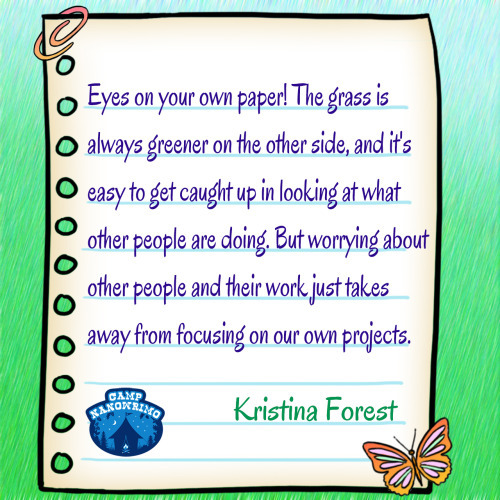
“Eyes on your own paper! The grass is always greener on the other side, and it’s easy to get caught up in looking at what other people are doing. But worrying about other people and their work just takes away from focusing on our own projects.”
—Kristina Forest is the author of YA romance novels, including I Wanna Be Where You Are and Now That I’ve Found You. She earned her MFA in Creative Writing with a concentration in Writing for Children at The New School. She lives in New York City with two huge bookshelves.
Thank Kristina for her Camp Care Package!
Your Camp Care Package is brought to you by Camp NaNoWriMo. Sign up to receive more Camp Care Packages at nanowrimo.org!
Image graphic created by NaNoWriMo Editorial Intern Jordan Leigh.
Image description: A green-blue background with a grasslike texture framing an illustrated piece of notebook paper with a paperclip in the top left corner and an orange and pink butterfly in the bottom right corner. The blue and white Camp NaNoWriMo logo is in the bottom left corner. The text on the notebook paper reads: ““Eyes on your own paper! The grass is always greener on the other side, and it’s easy to get caught up in looking at what other people are doing. But worrying about other people and their work just takes away from focusing on our own projects.” —Kristina Forest”
Chris Baty's Blog
- Chris Baty's profile
- 63 followers



